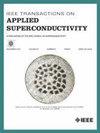Study of HTS Energy-Saving Superconducting Magnet Options for the PSI Particle Beam Lines
IF 1.7
3区 物理与天体物理
Q3 ENGINEERING, ELECTRICAL & ELECTRONIC
引用次数: 0
Abstract
In recent years, particle accelerator facilities have become more aware of the sustainability of their scientific research activity investing in new energy-efficient technologies and energy management of their infrastructure. To address this issue, focusing on medium- to high-energy range proton and heavy ion beamlines, a growing interest in using superconducting magnets instead of energy-demanding resistive configurations has been observed. The proposed study, conducted by the research team from the University of Milan and the Istituto Nazionale di Fisica Nucleare (INFN), Milano, Laboratorio di Acceleratori e Superconduttività Applicata (LASA) lab, focuses on the development of steady-state magnet designs based on high-temperature superconductor (HTS) ReBCO (rare earth copper oxide) tapes. The paper presents a comparative analysis of energy consumption reduction in superferric dipole case studies for the Paul Scherrer Institut (PSI) accelerator complex, focusing on replacing conventional resistive coils with HTS windings optimized at 50 K in a window frame or h-type iron yoke. The outcomes of the proposed designs are compared against the existing resistive magnet performances, showing a strong advantage of this innovative approach for large-scale research facilities in terms of energy consumption and cost-effectiveness.用于PSI粒子束线的高温超导节能磁体选择研究
近年来,粒子加速器设施更加意识到其科学研究活动的可持续性,投资于新的节能技术和基础设施的能源管理。为了解决这个问题,关注中高能范围的质子和重离子束线,人们对使用超导磁体代替能量要求高的电阻结构越来越感兴趣。这项研究是由米兰大学和意大利国家核物理研究所(INFN)、米兰加速器和超导应用实验室(LASA)的研究小组进行的,重点是基于高温超导体(HTS) ReBCO(稀土铜氧化物)带的稳态磁铁设计的发展。本文对Paul Scherrer研究所(PSI)加速器的超铁偶极子案例研究进行了能耗降低的比较分析,重点是用在窗框或h型铁轭中在50 K下优化的高温超导绕组取代传统的电阻线圈。将提出的设计结果与现有的电阻磁体性能进行比较,显示出这种创新方法在能源消耗和成本效益方面对大型研究设施的强大优势。
本文章由计算机程序翻译,如有差异,请以英文原文为准。
求助全文
约1分钟内获得全文
求助全文
来源期刊

IEEE Transactions on Applied Superconductivity
工程技术-工程:电子与电气
CiteScore
3.50
自引率
33.30%
发文量
650
审稿时长
2.3 months
期刊介绍:
IEEE Transactions on Applied Superconductivity (TAS) contains articles on the applications of superconductivity and other relevant technology. Electronic applications include analog and digital circuits employing thin films and active devices such as Josephson junctions. Large scale applications include magnets for power applications such as motors and generators, for magnetic resonance, for accelerators, and cable applications such as power transmission.
 求助内容:
求助内容: 应助结果提醒方式:
应助结果提醒方式:


